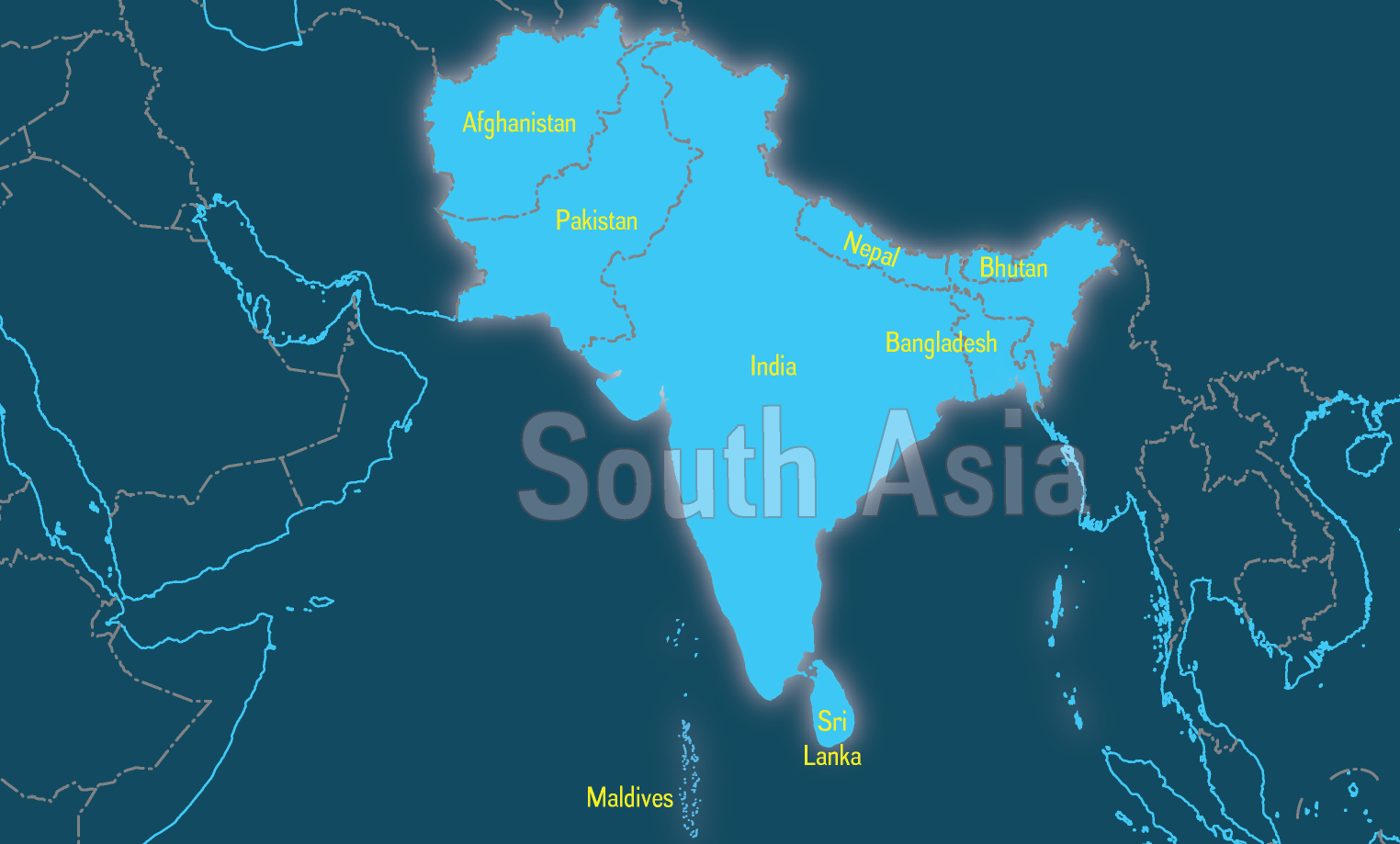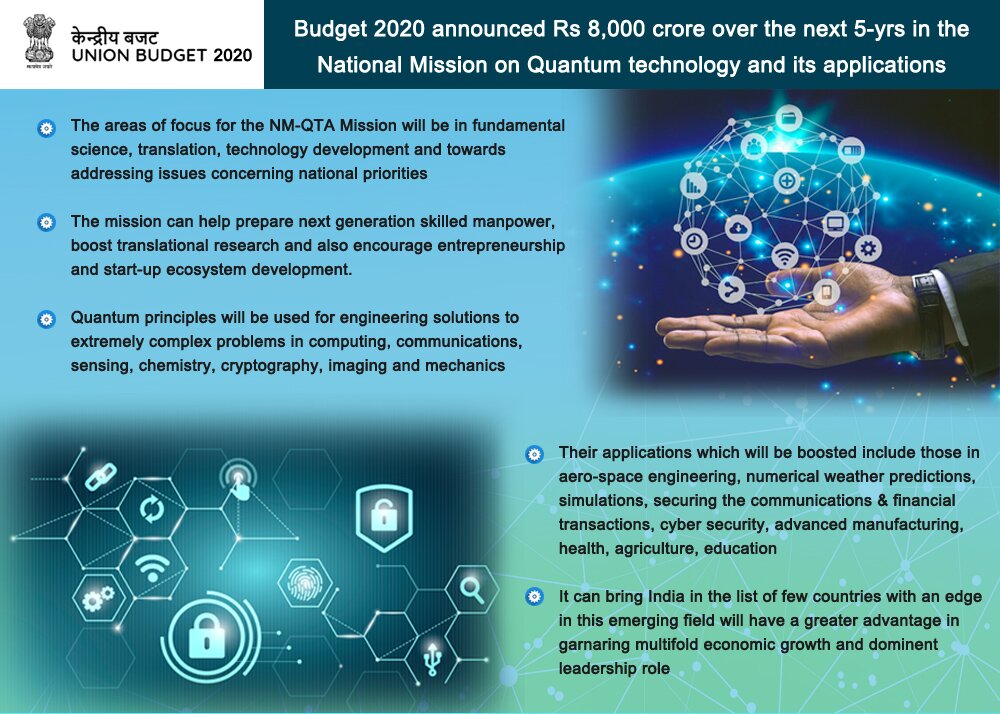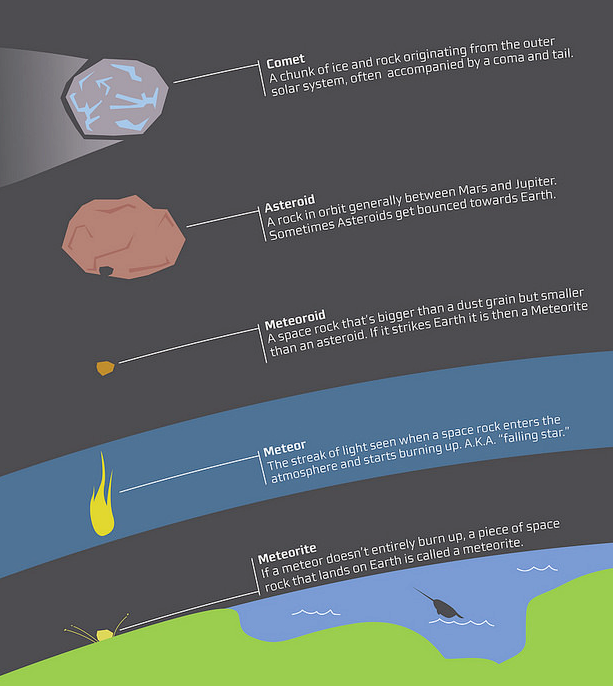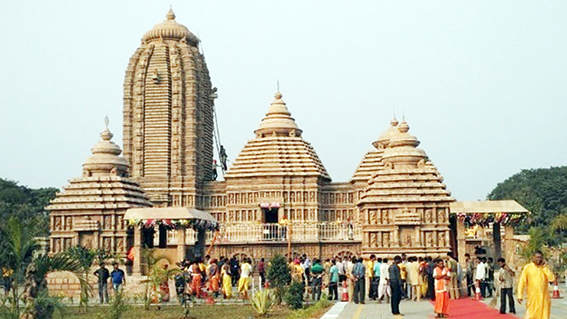International Relations
China’s Rising Influence in South Asia
Why in News
China has held its third multilateral dialogue virtually with countries from South Asia to take forward closer cooperation on fighting Covid-19 and coordinating their economic agendas, reflecting a new approach in Beijing’s outreach to the region.
Key Points
- Participating countries:
- It brought together every country in the region barring India, Bhutan and the Maldives, and was aimed at “anti-epidemic cooperation and poverty reduction cooperation”.
- The recent meeting was attended by all five countries that have taken part in these dialogues: Pakistan, Nepal, Afghanistan, Sri Lanka and Bangladesh.
- All three dialogues have been attended by Pakistan and Nepal.
- Engagements through other Platforms:
- Previously at the July quadrilateral dialogue with Afghanistan, Nepal and Pakistan, China’s proposed extending the China-Pakistan Economic Corridor (CPEC) to Afghanistan, as well as taking forward an economic corridor plan with Nepal, called the Trans-Himalayan Multi-dimensional Connectivity Network.
- Other Initiatives by China to Enhance Engagement in South Asia:
- According to the American Enterprise Institute’s China Global Investment Tracker, China has committed around 100 billion USD in the economies of Afghanistan, Bangladesh, the Maldives, Pakistan, Nepal and Sri Lanka.
- China is now the largest overseas investor in the Maldives, Pakistan, and Sri Lanka.
- Afghanistan:
- Beijing was a part of the trilateral China-Pakistan-Afghanistan foreign ministers dialogue which focuses on facilitating Afghan domestic political reconciliation, enhancing regional connectivity, and improving regional common development.
- The trilateral discussions also agreed to push “forward under the Belt and Road Initiative (BRI)” and “to enhance connectivity by extending the CPEC to Afghanistan”.
- Bangladesh:
- China and Bangladesh pledged to deepen defense cooperation, especially in the areas of “defense industry and trade, training, equipment and technology.
- China is also the largest arms supplier of the Bangladeshi military, providing 71.8% of weapons from 2008 to 2018.
- Bhutan
- It does not have diplomatic relations with China.
- Maldives:
- China’s relationship with the Maldives is near-exclusively focused on leveraging BRI to develop Maldives as well as to raise Chinese influence there to counter India.
- Nepal:
- Chinese President went to Nepal in 2019.
- This was the first visit by a Chinese head of state in 23 years.
- The countries have signed agreements to accelerate Infrastructure building in Nepal and improve connectivity between them.
- Both the countries have also announced the launch of a feasibility study of the China-Nepal cross-border railway.
- Chinese President went to Nepal in 2019.
- Sri Lanka:
- Sri Lanka handed over Hambantota port on a 99-year lease to China to repay its loan back to china. Hambantota is geostrategically located on the Indian Ocean, potentially bolstering Beijing’s String of Pearls.
- According to the American Enterprise Institute’s China Global Investment Tracker, China has committed around 100 billion USD in the economies of Afghanistan, Bangladesh, the Maldives, Pakistan, Nepal and Sri Lanka.
- Concerns for India:
- Security Concerns:
- Growing cooperation between Pakistan and China.
- Increasing nexus between Nepal and China.
- Acceptance to China-Pakistan Economic Corridor by south asian countries.
- Leadership Roles in South Asia:
- It shows increasing chinese presence in south asia and its acceptance by the countries as a torch bearer for the region which India wants for itself.
- Economic Concerns:
- Over the past decade, China has replaced India as the major trading partner of several South Asian countries. For instance, the share of India’s trade with Maldives was 3.4 times that of China’s in 2008. But by 2018, China’s total trade with Maldives slightly exceeded that of India.
- China’s trade with Bangladesh is now about twice that of India. China’s trade with Nepal and Sri Lanka still lags India’s trade with those countries but the gap has shrunk.
- Security Concerns:
Way forward
- India does not have the economic capacity as China. Thus it should cooperate with China for the development of these countries such that fruits of development collectively reach South Asia.
- It should also strongly condemn the plans for extension of the China-Pakistan Economic Corridor.
- Further India should invest in these countries where China falls short and maintain its good will in South Asia and prevent these nations from slipping off from India’s Influence.
Science & Technology
Quantum Technology
Why in News
The detailed project report for a National Mission on Quantum Technology and Applications (NMQTA) has been drawn out and finalised.
- Union Budget 2020-21 proposed to spend Rs 8,000 crore on the newly launched NMQTA.
- In 2018, the Department of Science & Technology unveiled a programme called Quantum-Enabled Science & Technology (QuEST) and committed to investing Rs. 80 crore over the next three years to accelerate research.
- The mission seeks to develop quantum computing linked technologies amidst the second quantum revolution and make India the world’s third-biggest nation in the sector after the US and China.
Key Points
- About Quantum Technology/Computing:
- Quantum Technology is based on the principles of Quantum mechanics that was developed in the early 20th century to describe nature at the scale of atoms and elementary particles.
- The first phase of this revolutionary technology has provided the foundations of our understanding of the physical world, including the interaction of light and matter, and led to ubiquitous inventions such as lasers and semiconductor transistors.
- A second revolution is currently underway with the goal of putting properties of quantum mechanics in the realms of computing.
- Difference Between Conventional and Quantum Computing:
- Conventional computers process information in ‘bits’ or 1s and 0s, following classical physics under which our computers can process a ‘1’ or a ‘0’ at a time.
- Quantum computers compute in ‘qubits’ (or quantum bits). They exploit the properties of quantum mechanics, the science that governs how matter behaves on the atomic scale.
- In this scheme of things, processors can be a 1 and a 0 simultaneously, a state called quantum superposition.
- Because of quantum superposition, a quantum computer — if it works to plan — can mimic several classical computers working in parallel.
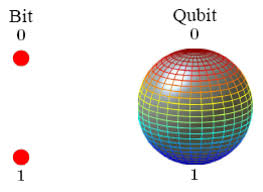
- Properties of Quantum Computing:
- The basic properties of quantum computing are superposition, entanglement, and interference.
- Superposition:
- It is the ability of a quantum system to be in multiple states simultaneously.
- The example of superposition is the flip of a coin, which consistently lands as heads or tails—a very binary concept. However, when that coin is in mid-air, it is both heads and tails and until it lands, heads and tails simultaneously. Before measurement, the electron exists in quantum superposition.
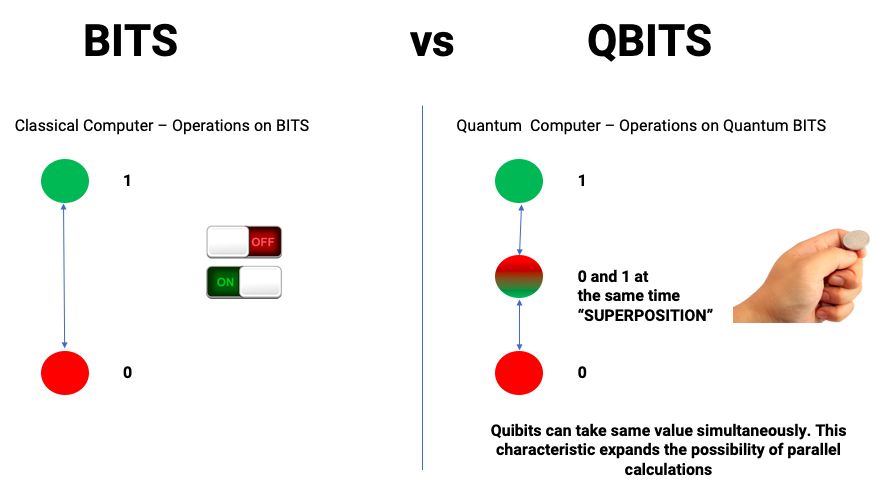
- Entanglement:
- It means the two members of a pair (Qubits) exist in a single quantum state. Changing the state of one of the qubits will instantaneously change the state of the other one in a predictable way. This happens even if they are separated by very long distances.
- Einstein called spooky ‘action at a distance’.

- Interference:
- Quantum interference states that elementary particles(Qubits) can not only be in more than one place at any given time (through superposition), but that an individual particle, such as a photon (light particles) can cross its own trajectory and interfere with the direction of its path.
- Superposition:
- The basic properties of quantum computing are superposition, entanglement, and interference.
- Applications of Quantum Technology:
- Secure Communication:
- China recently demonstrated secure quantum communication links between terrestrial stations and satellites.
- This area is significant to satellites, military and cyber security among others as it promises unimaginably fast computing and safe, unhackable satellite communication to its users.
- Research:
- It can help in solving some of the fundamental questions in physics related to gravity, black hole etc.
- Similarly, the quantum initiative could give a big boost to the Genome India project, a collaborative effort of 20 institutions to enable new efficiencies in life sciences, agriculture and medicine.
- Disaster Management:
- Tsunamis, drought, earthquakes and floods may become more predictable with quantum applications.
- The collection of data regarding climate change can be streamlined in a better way through quantum technology.
- Pharmaceutical:
- Quantum computing could reduce the time frame of the discovery of new molecules and related processes to a few days from the present 10-year slog that scientists put in.
- Augmenting Industrial revolution 4.0:
- Quantum computing is an integral part of Industrial revolution 4.0.
- Success in it will help in Strategic initiatives aimed at leveraging other Industrial revolution 4.0 technologies like the Internet-of-Things, machine learning, robotics, and artificial intelligence across sectors will further help in laying the foundation of the Knowledge economy.
- Secure Communication:
- Challenges Associated with Quantum Computing:
- The dark side of quantum computing is the disruptive effect that it can have on cryptographic encryption, which secures communications and computers.
- It might pose a challenge for the government also because if this technology goes into wrong hands, all the government’s official and confidential data will be at a risk of being hacked and misused.
Way Forward
- Long after the birth of social media and artificial intelligence, there are now demands to regulate them. It would be prudent to develop a regulatory framework for quantum computing before it becomes widely available.
- It will be better to regulate it or define the limits of its legitimate use, nationally and internationally before the problem gets out of hand like nuclear technology.
Biodiversity & Environment
CAFE-2 Regulations and BS-VI Stage II Norms
Why in News
The auto industry has requested the government to defer the implementation of Corporate Average Fuel Efficiency (CAFE-2) regulations and BS-VI stage II norms to April 2024, given the impact of the lockdown measures.
- As of now, the CAFE-2 norms and BS-VI stage II norms are set to come into effect in 2022 and April 2023 respectively.
Key Points
- Corporate Average Fuel Efficiency (CAFE-2) Regulations:
- About:
- CAFE or Corporate Average Fuel Efficiency/Economy regulations are in force in many advanced as well as developing nations, including India.
- They aim at lowering fuel consumption (or improving fuel efficiency) of vehicles by lowering Carbon dioxide (CO2) emissions, thus serving the twin purposes of reducing dependence on oil for fuel and controlling pollution.
- Corporate Average refers to sales-volume weighted average for every auto manufacturer. The idea of CAFÉ is to push manufacturers to achieve fuel efficiency targets by producing and selling more fuel-efficient models, including electric vehicles
- Launch in India:
- The CAFÉ standards were first notified in 2017 by the Union Ministry of Power (MoP) under Energy Conservation Act, 2001.
- The regulation is in accordance with the fuel consumption standards of 2015 that aim to increase fuel efficiency of vehicles road by 35% by 2030.
- The Ministry of Road Transport and Highways (MoRTH) is the nodal agency responsible for monitoring and reporting a summary of annual fuel consumption by automobile manufacturers at the end of each fiscal year.
- The regulation was introduced in two target phases: Carbon dioxide emission target of 130 gram/kilometre by 2022-23 and 113 g/km 2022-23 onwards.
- The CAFÉ standards were first notified in 2017 by the Union Ministry of Power (MoP) under Energy Conservation Act, 2001.
- Applicability:
- The norms are applicable for petrol, diesel, Liquefied Petroleum Gas (LPG) and Compressed Natural Gas (CNG) passenger vehicles.
- About:
- BS-VI Stage II Norms:
- Bharat Stage (BS) emission standards are laid down by the government to regulate the output of air pollutants from internal combustion engine and spark-ignition engine equipment, including motor vehicles.
- These standards are targeted at making improvements in three areas - emission control, fuel efficiency and engine design.
- The central government has mandated that vehicle makers must manufacture, sell and register only BS-VI (BS6) vehicles from 1st April, 2020.
- BS-VI is equivalent to Euro-VI norms currently in place across countries in Europe.
- As per BS-VI emission norms, petrol vehicles will have to effect a 25% reduction in their NOx, or nitrogen oxide emissions. Diesel engines will have to reduce their HC+NOx (hydro carbon + nitrogen oxides) by 43%, their NOx levels by 68% and particulate matter levels by 82%.
- Sulphur content in fuel is a major cause for concern. BS-VI fuel's sulphur content is much lower than BS-IV fuel. It is reduced to 10 mg/kg max in BS-VI from 50 mg/kg under BS-IV.
- Some of the measures to be introduced from 2023 onwards include deciding the confirmatory factor for in-service compliance, market surveillance and independent verification testing of in-use vehicles by regulatory authorities, adoption of more stringent driving cycle for emissions testing, public disclosure of emissions data by the manufacturers on publicly accessible websites, and on-board fuel consumption meters among others.
Governance
Pravasi Bharatiya Divas
Why in News
Pravasi Bharatiya Divas (PBD) is celebrated on 9th January every year to mark the contribution of Overseas Indian community in the development of India.
- On the occasion, several events such as PBD Convention, Pravasi Bharatiya Samman Award and Bharat ko Janiye Quiz are organised.
Key Points
- Background:
- 9th January was chosen as the day to celebrate PBD since it was on this day in 1915 that Mahatma Gandhi, the greatest Pravasi, returned to India from South Africa, led India’s freedom struggle and changed the lives of Indians forever.
- PBD Conventions: These are held once every two years.
- PBD 2021: The 16th PBD Convention was held virtually in New Delhi. The theme was "Contributing to Aatmanirbhar Bharat".
- Chief Guest: President of Suriname Chandrikapersad Santokhi.
- Highlights:
- Response to the Pandemic:
- Despite dependence on critical things like PPE kits, masks, ventilators or testing kits, India developed its capabilities not only to become self-reliant but started exporting many things.
- India’s drugs regulator has approved the Oxford Covid-19 vaccine Covishield, manufactured by the Serum Institute, and indigenously developed Covaxin of Bharat Biotech for restricted emergency use in the country.
- Use of Technology:
- India is using technology to end corruption (Direct Benefit Transfer).
- Further, India's space programme and tech start-up ecosystem is a leader in the global sphere.
- Recent Initiatives:
- Including New Education Policy 2020 and Production Linked Subsidies Scheme.
- Initiatives for Indian Diaspora:
- Vande Bharat Mission, in which more than 45 lakh Indians were rescued during Corona times.
- Skilled Workers Arrival Database for Employment Support (SWADES), an initiative for returning immigrants from the Gulf and other areas.
- Global Pravasi Rishta Portal for better connectivity and communication with the Pravasi Bharatiyas.
- 75th Anniversary of India’s Freedom (2021):
- The Prime Minister asked the members of the diaspora and people in Indian Missions world over to prepare a portal, a digital platform where contribution of the Pravasi Bharatiyas in the freedom struggle of India can be documented.
- Response to the Pandemic:
- Pravasi Bharatiya Samman Award:
- It is the highest honour conferred on a Non-Resident Indian, Person of Indian Origin; or an organisation or institution established and run by Non-Resident Indians or Persons of Indian Origin, who have made significant contribution in better understanding of India abroad, support India's causes and concerns in a tangible way, community work abroad, welfare of local Indian community, philanthropic and charitable work, etc.
- During the PBD convention, select eminent Indian diaspora members are awarded the Pravasi Bharatiya Samman Awards in the presence of the President of India.
- 30 Winners of the 2021 Award: Including Suriname President Chandrikapersad Santokhi, Curacao Prime Minister Eugene Rhuggenaath and New Zealand minister Priyanca Radhakrishnan.
- Third Edition Bharat ko Janiye Quiz (2021):
- It was launched in 2015-16 in order to strengthen the engagement with young overseas Indians (18-35) and encourage them to know more about their country of origin.
- The first edition was held in 2015-16 and the second one in 2018-19.
- Fifteen winners of the Quiz were announced during the PBD convention and will be invited for an India Tour (Bharat ko Janiye Darshan) after Covid.
Science & Technology
MukundPura Meteorite
Why in News
A recent study has shed light on the mineralogy of the meteorite named Mukundpura CM2 which fell in Mukundpura village near Jaipur in 2017.
- A meteorite is a solid piece of debris from an object, such as a comet, asteroid, or meteoroid, that originates in outer space and survives its passage through the atmosphere to reach the surface of a planet or moon.
Key Points
- About:
- The meteorite named Mukundpura CM2 was classified to be a carbonaceous chondrite. The composition of carbonaceous chondrites are also similar to the Sun.
- Chondrites are silicate droplet bearing meteorites, and this Mukundpura chondrite is the 5th carbonaceous meteorite known to fall in India.
- Classification Of Meteorite:
- Meteorites are classified into three groups: Stony (silicaterich), Iron (Fe–Ni alloy), and Stony Iron (mixed silicate iron alloy).
- Mukundpura CM2 is a type of stony meteorite, considered the most primitive meteorite and a remnant of the first solid bodies to accrete in the solar system.
- Components of Meteorite:
- Detailed spectroscopic studies revealed that the meteorite had very high (about 90%) phyllosilicate minerals comprising both magnesium and iron.
- Forsterite and FeO olivine, calcium aluminium rich inclusion (CAI) minerals.
- Few magnetites, sulphides, aluminium complexes and calcites were also found.
- Importance of studying Asteroid:
- Understanding of Solar system's history.
- How the solar system evolved into the Sun and planets of today.
- The effects of impact of meteorites.
- They are often rich in volatiles and other minerals and can be exploited for future planetary exploration.
Difference between Meteor, Meteorite and Meteoroid
- When meteoroids enter Earth's atmosphere (or that of another planet, like Mars) at high speed and burn up, the fireballs or “shooting stars” are called meteors.
- When a meteoroid survives a trip through the atmosphere and hits the ground, it's called a meteorite.
Geography
Domestic Exploration of Lithium
Why in News
Recent surveys by the Atomic Minerals Directorate for Exploration and Research (AMD) have shown the presence of lithium resources in Mandya district, Karnataka.
- AMD is the oldest unit of the Department of Atomic Energy.
Key Points
- About Lithium:
- Properties:
- It is a chemical element with the symbol Li.
- It is a soft, silvery-white metal.
- Under standard conditions, it is the lightest metal and the lightest solid element.
- It is highly reactive and flammable, and must be stored in mineral oil.
- It is an alkali metal and a rare metal.
- The alkali metals consist of the chemical elements lithium, sodium, potassium, rubidium, caesium, and francium. Together with hydrogen they constitute group 1, which lies in the s-block of the periodic table.
- Rare Metals (RM) include Niobium (Nb), Tantalum (Ta), Lithium (Li), Beryllium (Be), Cesium (Cs) etc. and Rare Earths (RE) include Lanthanum (La) to Lutetium (Lu) besides Scandium (Sc) and Yttrium (Y).
- These metals are strategic in nature with wide application in the nuclear and other high tech industries such as electronics, telecommunication, information technology, space, defense etc.
- Uses:
- Lithium metal is used to make useful alloys.
- For example, with lead to make ‘white metal’ bearings for motor engines, with aluminium to make aircraft parts, and with magnesium to make armour plates.
- In Thermonuclear reactions.
- To make electrochemical cells. Lithium is an important component in Electric Vehicles, Laptops etc.
- Lithium metal is used to make useful alloys.
- Properties:
- Lithium Resources in Karnataka:
- The survey shows presence of 1,600 tonnes of lithium resources in the igneous rocks of the Marlagalla-Allapatna region of Karnataka’s Mandya district.
- Benefits of Domestic Exploration:
- Reducing Import Bill:
- India currently imports all its lithium needs. Over 165 crore lithium batteries are estimated to have been imported into India between 2016-17 and 2019-20, at an estimated import bill of upwards of USD 3.3 billion.
- Reducing Overdependence on China:
- China is a major source of lithium-ion energy storage products being imported into the country.
- Reducing Import Bill:
- Issues Associated with Domestic Exploration:
- The new find is categorised as “inferred”.
- The ‘inferred’ mineral resource is the part of a resource for which quantity, grade and mineral content are estimated only with a low level of confidence based on information gathered from locations such as outcrops, trenches, pits, workings, and drill holes that may be of limited or uncertain quality, and also of lower reliability.
- The lithium find is comparatively small, considering the size of the proven reserves in Bolivia, Argentina, Australia, and China respectively.
- India is seen as a late mover in attempts to enter the lithium value chain, coming at a time when Electric Vehicles are predicted to be a sector ripe for disruption.
- 2021 is likely to be a turning point for battery technology with several potential improvements to the li-ion technology, and alternatives to this tried-and-tested formulation in advanced stages of commercialisation.
- The new find is categorised as “inferred”.
- Extraction Method:
- Lithium can be extracted in different ways, depending on the type of the deposit .
- Solar evaporation of large brine pools.
- A brine pool is a volume of brine collected in a seafloor depression.
- For example: Brines of Sambhar and Pachpadra in Rajasthan.
- Hard-rock extraction of the ore (a metal-bearing mineral).
- For example: rock mining at Mandya.
- Solar evaporation of large brine pools.
- Lithium can be extracted in different ways, depending on the type of the deposit .
- Other Potential Sites:
- The major mica belts in Rajasthan, Bihar, and Andhra Pradesh.
- Pegmatite (igneous rocks) belts in Odisha and Chhattisgarh.
- Brines of Sambhar and Pachpadra in Rajasthan, and Rann of Kachchh in Gujarat.
- Other Government Initiative:
- India, through a newly state-owned company Khanij Bidesh India Ltd, had signed an agreement with an Argentinian firm to jointly prospect lithium in Argentina that has the third largest reserves of the metal in the world.
- The company has a specific mandate to acquire strategic mineral assets such as lithium and cobalt abroad.
- India, through a newly state-owned company Khanij Bidesh India Ltd, had signed an agreement with an Argentinian firm to jointly prospect lithium in Argentina that has the third largest reserves of the metal in the world.
Important Facts For Prelims
Jagannath Temple
Why in News
Recently, the Shree Jagannath Temple Administration (SJTA) announced that devotees don't need to produce their Covid-19 negative report for getting entry into the shrine in Puri from January 21.
- At present devotees entering the temple have to show Covid-19 negative reports.
- The temple opened to the public from 3rd January after remaining closed for nine months in the wake of the pandemic.
Key Points
- The temple is believed to be constructed in the 12th century by King Anatavarman Chodaganga Deva of the Eastern Ganga Dynasty.
- Jagannath Puri temple is called ‘Yamanika Tirtha’ where, according to the Hindu beliefs, the power of ‘Yama’, the god of death has been nullified in Puri due to the presence of Lord Jagannath.
- This temple was called the “White Pagoda” and is a part of Char Dham pilgrimages (Badrinath, Dwaraka, Puri, Rameswaram).
- There are four gates to the temple- Eastern ‘Singhdwara’ which is the main gate with two crouching lions, Southern ‘Ashwadwara’, Western 'Vyaghra Dwara and Northern ‘Hastidwara’. There is a carving of each form at each gate.
- In front of the entrance stands the Aruna stambha or sun pillar, which was originally at the Sun Temple in Konark.

